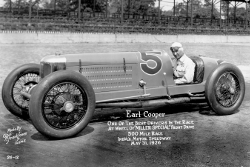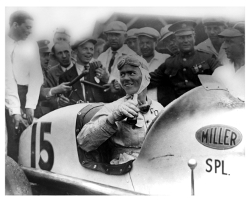In the build up to the 2014 Indianapolis 500, The Checkered Flag is looking back on significant races that have contributed to the glorious history of the 97 500s that have been and gone.
——————-
The history of the Indianapolis 500 is full of underdog winners, among them the eight times – discounting the inaugural event of 1911 – that a rookie at the Speedway has ended his first Month of May in victory lane.
That count includes three consecutive years in the late 1920s, kicked off by the 1926 when Frank Lockhart added his name to the track’s role of honour on his first attempt at the race.
Lockhart’s Indy 500 was not the underdog victory that his rookie status suggests. The 23-year-old had proved himself a stellar driver in the touring circus of races on America’s Pacific Coast and having used the company’s cars to such good effect he was given a spot on the factory Miller team at the Brickyard. The landscape of the Indianapolis 500 of the 1920 was dominated by the names Miller and Duesenberg. The two camps shared the race victories for eight years from 1922. When Lockhart arrived at Indy Duesenbergs had won the last two races. 1926, however was to be a crushing victory for Harry Miller‘s eponymous team, though his stable was responsible for half of the 28 car field at Indy that year.
Despite the sheer number of cars under Miller’s control – including a pair of front-wheel drive machines – and his California racing pedigree Lockhart was only part of the team as a reserve driver to Peter Kreis, starting his second 500.
Lockhart proved himself faster than some of Miller’s front line drivers – including Kreis – but still he remained a reserve driver. At that point history played its hand – Kreis fell ill with flu before qualifying and the rapid Lockhart was the obvious man to call up to the wheel of the #15 car.

Earl Cooper’s low-slung front drive started from pole (Credit: Indycar media)
He repaid the faith that Kreis had placed in him by setting a new single lap qualifying record on his first timed lap. However, a blown tyre would cause him to crash on his second timed lap and when an engine problem wrote off a second attempt Lockhart was struggling to make his way into the race at all. With discretion the better part of valour Lockhart made sure of his start with a relatively slow run at an average speed of 95.783mph. Compare that to his new single lap record of 115.488mph and pole speed of 111.735mph set by Earl Cooper in one of the front wheel drive Millers. Harry Hartz – in a rear drive Miller – was second fastest, Leon Duray third in his Locomobile Junior 8.
Bon McDougall – another from the Miller stable – was the best of the dozen members of the rookie class.
Lockhart was just 20th.
Once the race began on May 31 that would change. Quickly.
It took only a handful of laps for him to climb up the order into the top five, the early running being set by Phil Shafer and Dave Lewis who had started from the middle and inside, respectively, of the second row. As Shafer fell away from the lead having led 16 of the first 22 laps Lewis – Harry Miller’s brother-in-law in the second front drive Miller – had to hold off Lockhart for the lead. He had to give best in the battle to complete a pitstop on lap 59, Lockhart taking the lead for the first time.
History took that moment to intervene again bringing the Indy 500 under the red flag for rain for the first time its history. The race was placed on pause for around an hour before the battle between Lockhart and Lewis at the front of the field could restart.
When it did so Lockahart was able to hold onto the lead over the runner-up in the 1925 ‘500, Lewis having to retire from the race after 92 laps. The mantle of the nearest challenge passed back to Hartz.
Hartz was starting his fifth 500 in 1926 and already having a pair each of runner-up finishes and fourth places would have surely been one of the favourites to win the 1926 edition.
He did take the lead just after the 100 lap mark, Lockhart pitting from the lead, but when Hartz suffered a delay in his own pitstop

Lockhart’s ’26 victory launched him on a soaring, yet ultimately tragic, path (Credit: Indycar media)
only five laps later Lockhart was able to move into an unassailable lead. When the rain returned on lap 160 Lockhart was two full laps ahead of Hartz, the final red flag cementing the result in place and making the 1926 race the first Indy 500 to have been curtailed by rain. A third second place for Hartz added to an Indy CV which kept him as a bridesmaid behind the wheel.
Cliff Woodbury, completed the same number of laps as Hartz to take third in his first Indy 500 start. It would be his best result in four attempts at the 500, including the 1929 event which he started from pole position before crashing to a 33rd and last place finish on lap three.
All the major players from the 1926 race would return to the speedway. Lewis would finish last in 1927 before taking his own life a year later.
Lockhart would enter his own rear wheel drive Miller in the 1927 race as factory team put their weight behind the front wheel drive version. He would complete the only part of his ’26 May which went awry by taking pole position with a new speed record, leading the first 81 laps before having to retire from the race after 120 laps.
His pursuit of speed – fuelled by his engineering acumen – put him on the trail of the Land Speed Record. The quest was to cost him his life less than two years after his 500 triumph when the custom built Stutz Blackhawk he was driving crashed at Daytona Beach.
Peter Kreis, the man who had given Lockhart the opportunity he needed, would make five further starts at Indianapolis but was never able to improve upon his tenth place from 1925. He – and his riding mechanic – were killed in an accident while practicing for the 1934 500.
Harry Hartz would see one more Indy 500 as a driver, a mechanical failure in 1927 snapping his enviable string of top five finishes.
Happily, however, he would get to celebrate victory at Indianapolis Motor Speedway as the owner of the Miller-Hartz driven by Billy Arnold to victory in 1930.
The Miller company that had put all the men on track for 1926 folded in 1933. However, Miller’s Indy 500 legacy stretched well beyond Harry Miller’s death in 1943 with his four cylinder engine design the basis for the Offenhauser engine that would become near synonymous with decades of the 500’s history.
www.theCheckeredFlag.co.uk will be providing full coverage of the 98th Indy 500 both on Twitter at @TheCheckerFlag as well as here on the website.



